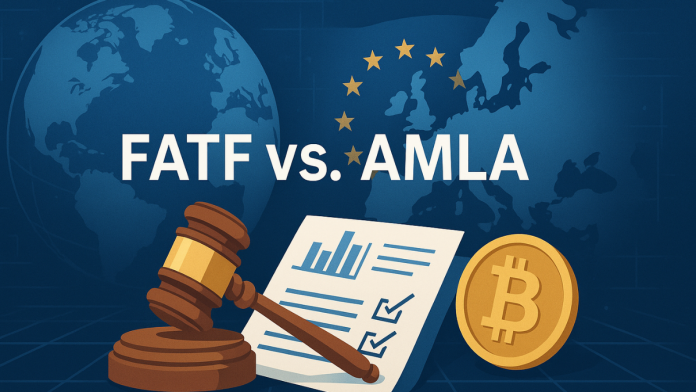Money laundering moves billions through global financial systems, fueling crime and dodging regulators. Two key players in the fight against financial crime—the Financial Action Task Force (FATF) and the European Union’s Anti-Money Laundering Authority (AMLA)—approach their roles very differently. While FATF sets global standards, AMLA enforces them directly within the EU.
This article focuses on their supervisory authority and enforcement mechanisms—how each monitors compliance, enforces rules, and ensures banks and businesses play by them. Understanding these differences reveals why both are critical—and why they operate in distinctly different ways to combat illicit finance.
FATF’s Supervisory Approach and Enforcement
Established in 1989 by the G7, FATF operates from Paris with 39 member countries. It doesn’t have enforcement boots on the ground but acts as a global standard-setter. Its 40 Recommendations form the foundation of AML/CFT (anti-money laundering/countering the financing of terrorism) frameworks worldwide, covering everything from customer due diligence to suspicious transaction reporting. However, FATF lacks enforcement power—it can’t compel countries to act.
Instead, FATF oversees compliance through mutual evaluations, where member countries assess one another’s AML/CFT frameworks. Think of it as a global peer-review audit. If a country is found lacking—say, by allowing shell companies to hide true ownership—FATF flags it. Persistent shortcomings can land a jurisdiction on the grey list (under enhanced monitoring) or the blacklist (high-risk and subject to countermeasures).
Europe strikes back: new anti-money laundering agency AMLA launches to crush dirty money networks
These lists carry weight. For instance, when Pakistan was grey-listed (2018–2022), it rapidly amended legislation to avoid losing access to international finance and trade. FATF’s influence stems from economic and reputational pressure—not legal enforcement.
This global approach is effective because it’s adaptable across jurisdictions, from Nigeria to Norway. However, it’s slow-moving: evaluations follow a six-year cycle, and enforcement depends on each country’s willingness to act. When states stall or resist, FATF can only “name and shame.”
AMLA’s Supervisory Authority and Enforcement
In contrast, the European Union launched AMLA in June 2024, headquartered in Frankfurt, to strengthen its internal AML regime. Unlike FATF, AMLA wields direct supervisory power.
It will oversee up to 40 high-risk financial entities, including large banks and crypto platforms operating across multiple EU countries. If a financial institution in Germany or Estonia shows weak AML controls, AMLA can audit, fine, or sanction it directly.
Crucially, AMLA also coordinates the work of national Financial Intelligence Units (FIUs) across the EU. It can enforce binding technical standards, leaving little room for national variation. For example, if a bank in France fails to report a suspicious crypto transfer, AMLA can intervene based on unified EU regulations—a level of enforcement FATF cannot match.
AMLA is also designed to correct inconsistent enforcement across the EU. For example, Cyprus has been criticized as a weak link in previous AML frameworks. By contrast, Malta—while also under scrutiny historically—should only be cited where clear evidence supports the claim.
However, AMLA’s direct supervision will only start in 2028. Until then, it is in a phase of coordination and capacity-building. Importantly, AMLA cannot freeze bank accounts—that authority still lies with national regulators. But it can impose monetary penalties and coordinate asset freeze implementation when warranted.
Comparison and Real-World Implications
FATF and AMLA are like a coach and a referee. FATF draws up the global game plan—its recommendations guide over 200 jurisdictions—but enforcement relies on peer pressure and national discretion. AMLA, meanwhile, is the enforcer, holding banks and crypto firms accountable across the EU with direct action and penalties.
FATF’s influence is broad. For instance, its greylisting of the UAE in 2022 prompted swift crypto compliance reforms. Yet, it lacks the tools to enforce directly. AMLA can act immediately—if a Dutch bank ignores EU AML rules, it faces real-time audits or fines.
Still, both frameworks face modern challenges. From decentralized finance to AI-driven laundering techniques, regulators are often playing catch-up.
FATF’s strength lies in its global flexibility, but that can lead to inconsistencies. AMLA ensures uniform enforcement, but is limited to the EU. The combination of FATF’s global reach and AMLA’s regulatory muscle offers a powerful one-two punch.
Bottom Line
FATF influences global policy through standard-setting and reputational consequences. AMLA enforces compliance through direct regulation and penalties within the EU. For financial institutions, FATF’s rules are best practices to follow; AMLA’s are mandatory—and backed by consequences.
As illicit finance evolves, the collaboration between these two bodies will be essential. Policymakers, regulators, and institutions must understand their complementary roles to maintain effective oversight and minimize blind spots in the fight against global money laundering.
